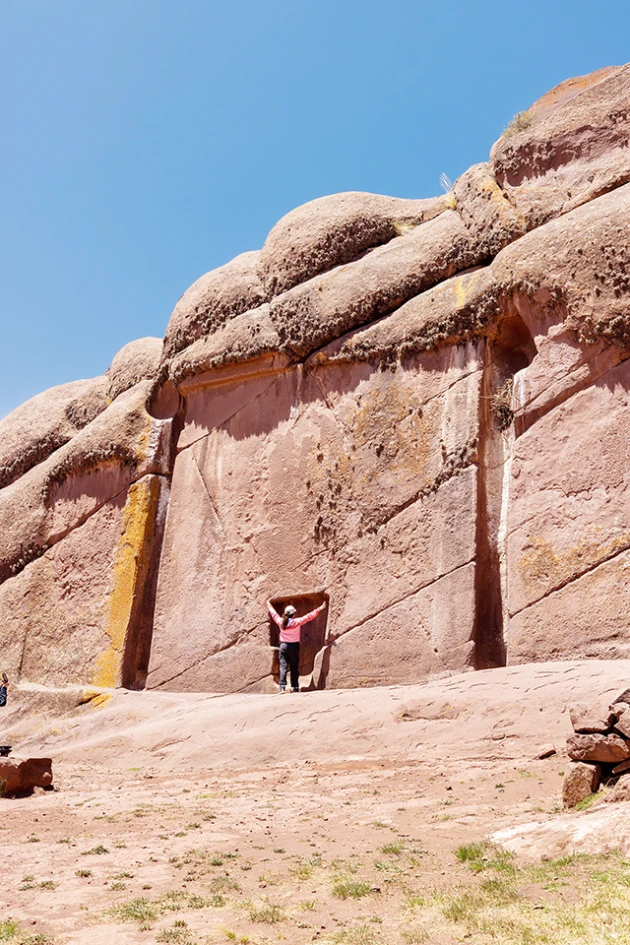A gateway carved with remarkable precision into the face of a rocky mountain in Peru may be one of the greatest archaeological mysteries of the world.
Measuring 7 meters high and 6.7 meters wide, the Aramu Muru has baffled archaeologists since its discovery in 1996, near Lake Titicaca in southern Peru. The carved surface features a T-shaped recess—about 2 meters high and 1 meter wide—that resembles a shallow portal leading to nowhere.
Photo: Shutterstock
Alongside the recess, there are two vertical grooves, which some experts believe could have had a decorative or even functional role.
Professor of archaeology, Mohamed Firoz Khan, believes the monument "was created by ancient pre-Incan civilizations," while alien theorists speculate about possible extraterrestrial involvement.
In a post on X (formerly Twitter), Khan writes: "The legends of Native Americans describe the Gate of the Gods as a passage through which heroes would meet their gods and gain immortality."
Visitors flock to the site, driven by rumors of supernatural energy and claims that it serves as a portal to other dimensions.
Traditional archaeologists continue to search for evidence regarding the monument's age and function, with the prevailing theory attributing its construction to the Tiwanaku civilization, which flourished from around 200 BCE to 1000 CE.
Photo: Shutterstock
"Despite the lack of solid evidence and the absence of further excavations since its discovery, Aramu Muru remains a protected archaeological site that captivates tourists and spiritual seekers with its mysterious allure and historical significance," Professor Khan remarked on X.
Though the exact use of the gate remains unknown, archaeologists speculate that it may have been used in some form of ritual, as a person can stand in the center of the recess.
The Tiwanaku people were known for their monumental stone construction. However, no organic materials have been found at the site that would allow for precise dating of the carved surface.
The carving style at Aramu Muru does not perfectly match that of the civilizations that inhabited the region 2,500 years ago.
Professor Khan, who holds a PhD in history with a specialization in archaeology, described Aramu Muru as an "enigmatic" monument that previously existed only in legends.
Photo: Shutterstock
The Aymara people, an indigenous population of the Altiplano region in the Andes, lived in the area from 1150 to 1477 and were aware of the site as the "Devil's Gate" or a place of spirits long before its discovery in the 1990s.
This people believed that the gate appeared magically and served as an entrance for shamans or selected individuals to communicate with spirits, seek visions, or embark on dangerous journeys to the underworld or celestial realms.
However, the Aymara typically avoided Aramu Muru, believing that unauthorized entry could trap the soul or anger the spirits—a belief rooted in their general reverence for natural landmarks as sacred.
At the time when Aramu Muru is believed to have been constructed, ancient peoples were still using simple tools made of stone, bone, and wood.
Yet, the massive gate is carved directly into red sandstone—a much softer material than others like granite.
This, according to conventional researchers, helps explain how such an intricate work could have been shaped using primitive tools.
The mysterious monument was discovered by José Luis Delgado Mamani, a local guide who stumbled upon it in 1996 while exploring the area. He later claimed that he was led there by dreams and family stories of a "gate" in the mountains.
However, the legend of Aramu Muru dates much further back in time.
The most popular myth surrounding the gate involves an Incan priest, Aramu Muru, who escaped from the Spanish conquistadors while carrying a sacred golden disk from the Coricancha temple in Cusco.
It is said that he activated the gate with the disk and escaped to another dimension or the spirit world, disappearing forever.
There is a recess at the center of the gate where, according to the legend, the disk was placed.
Aramu Muru was featured on the History Channel's Ancient Aliens program, which revealed that shamans still visit the gate to pray.
David Childress, one of the hosts, said: "Here we have this gigantic gate carved into solid rock, and it looks like an entrance, but it leads nowhere—it literally sits in the middle of nowhere."
George Tsoukalos, also a host of the show and a well-known proponent of extraterrestrial theories, added: "They want us to believe it's a coincidence, that it's fantasy. Nonsense! Something happened. It’s possible this solar disk had some extraterrestrial connection and was a technological device for transportation."
Another theory suggests that Aramu Muru might have been an entrance to an underground temple or complex, which was later sealed.
Other indigenous legends speak of ancient heroes who passed through the gate to meet their gods.
Tourists who have visited Aramu Muru have reported feeling "intense spiritual energy" when standing within the recess.
They also claim to have experienced vibrations, seen visions, or undergone energy shifts when touching the smaller carved spot.
However, scientific investigations have not yielded any findings, and no unusual electromagnetic fields, radiation, or geological anomalies have been detected to suggest anything beyond a simply carved rock.










